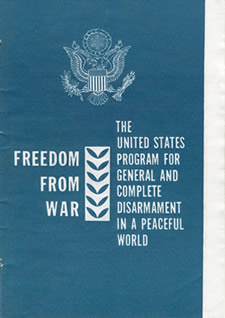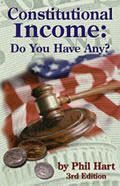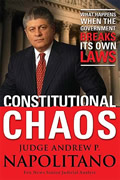Other
Ryter
Articles:
The Two Kerry's:
War Hero or
Traitor?
"Men in Black" The Cult of The Judges
THE
AGELESS AGENDA
By Jon Christian Ryter
June 9, 2005
NewsWithViews.com
The
federal government's war on the 2nd Amendment, blamed on Bill Clinton
by most diehard right-of-center conservatives, actually began during
the presidency of John F. Kennedy, shortly after the abortive Bay of
Pigs fiasco. The game plan, known as State Department Publication 7277,
was entitled  Freedom
from War: The United States Program for General and Complete Disarmament
in a Peaceful World.
Freedom
from War: The United States Program for General and Complete Disarmament
in a Peaceful World.
While most Americans today are aware of the fact that Publication 7277 called for the gradual transfer of all American military assets�men and machines�to the United Nations (which is forbidden by its charter from fielding an army), most people don't know that 7277 also detailed plans for the global disarming of private citizens as well. It would not bode well for the utopians to disarm the governments of the world and leave their people armed to the teeth.
The authors of the Kennedy plan�or rather, the Council on Foreign Relations plan since that is where the disarmament agenda was born�were CFR members Dean Rusk, Kennedy's Secretary of State, Secretary of Defense Robert McNamara and presidential advisors John McCoy and Robert Lovett. McCoy would be appointed to head the newly created US Arms Control and Disarmament Agency the following year. Lovett was offered his choice of cabinet positions in the Kennedy Administration and reportedly turned all of them down. He preferred the role of invisible advisor. In that capacity, Lovett handpicked most of those who became the inner circle of both the Kennedy and Johnson Administrations. Banning the private ownership of guns in America became the unspoken agenda of Congress since 1968 as legislators on both sides of the aisle insisted over the next two decades that their intent was never to ban the private ownership of guns but simply to regulate them to make sure that guns didn't get in the hands of criminals.
In point of fact, criminals simply don't go to the neighborhood gun store to purchase firearms. They buy guns on the black market from "dealers" who more times than not have criminal records themselves and who sell their inventory from the back trunks of their cars. More often than not, the guns the blackmarket dealers sell are not American-made firearms. They are guns manufactured in, and smuggled from, Central and South America, China and the Mideast. A small amount of the guns used in crimes in the United States are weapons that were stolen from American citizens who purchased and owned them legally. Acting as those the majority of the guns used in crimes were stolen from careless gun owners, Congress attempted to enact legislation that would have made legal gun owners whose weapons were stolen�and the gun dealers from whom they were legally purchased�financially responsible for any crimes committed with those weapons.
Four years after the enactment of the National Firearms Act, Roosevelt tried a second time to outlaw the private ownership of guns. This time, the legislation was called the Federal Firearms Act of 1938. The new law banned "gangster weapons" (tommy guns made popular not only by the Chicago bootleg gangs during Prohibition but gangsters like Machine Gun Kelly and Ma Barker). The law also banned "silencers" and all gadget-type guns such as "gentlemen" guns (those unobtrusively hidden in fancy canes) or those having the appearance of being cosmetic jewelry. The law expanded on the National Firearms Act by banning all short-barreled rifles and shotguns. What Roosevelt especially wanted banned were revolvers and pistols since Guiseppe Zangara used a .38 revolver when he attempted to assassinate FDR on Feb. 15, 1933 nineteen days before he was to assume office as the 32nd President of the United States.
It is important to note that in 1928 the freely-elected conservative Reichstag in Germany attempted to curtail the right of its citizens to own handguns not only out of fear of both the Nazis and the Communist�or because of the dramatic increase in political assassinations throughout Europe�but to show good faith to the League of Nations scheme to end war by gradually eliminating the weapons used to fight them. The global effort to ban guns began with a rash of political assassinations in Europe during the American Civil War, culminating with the assassination of Austrian Archduke Francis Ferdinand and his commoner wife were gunned down in Sarajevo by anarchist Gavrilo Princip on June 28, 1914.
When the first World War ended, the utopians�who still insisted that the assassination of the Archduke started the global war�were more determined than ever to disarm the people as the League of Nations disarmed their governments since it was armed anarchists and patriots who overthrew the Old World Order of Europe, creating parliamentary democracies out of Europe's monarchies. By the mid-1920's, as the League of Nations further developed its plan to erase all national borders and create a single global nation was formed, a wave of European national laws were being enacted to deprive European citizens of the right to own firearms.
England was first, enacting the Firearms Act of 1920. The Firearms Act of 1920 gave the Home Office sole authority to issue licenses for firearms. For that reason, very few licenses were issued. Only the titled or the wealthy, or those employed the titled or wealthy were able to obtain them. Owning an unlicensed firearm carried a stiff penalty. A gun roundup began even though the English Bill of Rights (1689) ostensibly granted its citizens the right to own firearms. "The [English] subjects which are Protestants, may have arms for their defense suitable to their conditions, as allowed by law." "As allowed by law" is the catch-phrase that permeates the UN Declaration on Human Rights. It's the waiver that allows government to retract any right on whim, and exclude anyone it wishes from the liberties granted by that right.
The Law on Firearms and Ammunition of 1928 was the first attempt by Germany to register firearms and regulate who could legally possess them. This was done, in part, to persuade their former enemies of their willingness to live in a war-free world. But, the government also feared the increasing number of anarchist socialists and fascists causing unrest from Bavaria to Berlin. The government feared a coup by either Bolsheviks or Nazis.
Negotiations between US Secretary of State Frank Kellogg, French Foreign Minister Aristide Briand and emissaries from England, Belgium, France, Poland, Australia, New Zealand, South Africa, Germany, the Czech Republic, Ireland, India, Japan, Italy, and the United States in 1928 created what became known as the Kellogg-Briand Pact�a universal nonaggression program for the world that was written by the fledgling Council on Foreign Relations for the fledgling League of Nations. In this accord was the spirit that would ultimately be incorporated into State Department Publication 7277�complete and total disarmament. Nations and peoples.
Interestingly, in 1938 when Hitler was already flexing his muscles in Europe, and the threat of war with Germany was looming larger in the minds of most Europeans, the British Home Office pulled the plug on issuing new gun licenses to British citizens who requested permission to buy handguns or rifles to protect their homes and families in the event the nation was invaded by Germany. Not only did the Home Office decline to issue new permits, it revoked many of the licenses it previously granted. Then, in a bizarre move to most, the British government passed a comprehensive firearms statute that eliminated the right of most British citizens to be armed. To many, it seemed that the government was preparing for the English people to capitulate should the Huns invade.
The rationale for disarming people whom the British government should have been arming was�according to a secret report that was declassified in the late 1970s�a growing fear by the British government that a communist or fascist revolution by the people of England was planned and might be staged as the Germans invaded the island nation.
Whenever governments fear its citizens, the first thing those governments will always do is disarm its citizens to protect itself from the people. A citizen militia armed with nothing more threatening than scythes, garden hoes, lawn rakes and axes does not pose much of a threat to a government armed with machine guns, tanks and guided missiles.
In Europe today, only one nation has never been invaded. Switzerland. During World War II, only one nation was allowed absolute neutrality. Switzerland. During the 20th century, the laws of only one nation in Europe mandated that every citizen must be armed. Switzerland. Today, in Europe, only the Swiss are armed to the teeth. Yet, Switzerland has the lowest crime rate of any industrialized nation in the world.
Using UN data compiled through 1996, the U.S. Department of Justice concluded that, in England, the robbery rate was 1.4 times higher, the assault rate was 2.3 higher, and the burglary rate was 1.7 times higher than in the United States. Only the murder and rape rates in the United States were higher than in England. Prior to the universal adoption of the UN Global Gun Ban Treaty by the nations of Europe and the former colonies of the British Empire (which worrisomely, has never shown up at the doorstep of the US Congress) England had the most restrictive gun control laws in the world.
The UN International Study on Firearm Regulation (1994) deliberately chose to delete Switzerland from its comparative analysis because the Swiss statistics contradict the study's hypothesis that a high rate of firearm ownership corresponds with high rates of violent crime. The Swiss Federal Police reported that, in 1997, there were 87 intentional homicides and 102 attempted homicides in the entire country. Ninety-one of the 189 incidents involved firearm. With a population of seven million (which includes 1.2 million foreigners), Switzerland had a homicide rate of 1.2 per 100,000. There were 2,498 robberies (and attempted robberies), of which 546 involved firearms, giving a robbery rate of 36 per 100,000. Almost 50% of the reported crimes were committed by non-resident foreigners, which is why one hears reference in casual talk to "criminal tourists."
To the gun control advocate, the statistics from Switzerland sounds made up. In 1993, not a single armed robbery was reported in Geneva Switzerland, which is awash in guns, has substantially lower murder and robbery rates than England, where guns are banned. The honest statistics prove that guns not only don't commit crimes, a well-armed public reduces the crime rate substantially. In addition, a well-armed nation reduces the likelihood of tyrannical governments overthrowing their citizens and establishing totalitarian dictatorships.
Had Franklin D. Roosevelt succeeded in outlawing the private ownership of guns in America as Adolph Hitler did in Germany and Josef Stalin did the Soviet Union�and ultimately, what Mao Tse-tung did when he seized China in 1949�FDR would have invoked an emergency decree suspending the Constitution during the "national emergency," and would have become America's second dictator. Only, in Roosevelt's case, the power would never have been returned to the people.
The Gun Control Act of 1968 actually began as the Gun Control Act of 1963 shortly after the assassination of President John F. Kennedy in Dallas, Texas. Congress' attempt to play on the emotions of America and use the passionate sentiments of people who were mourning the loss of a popular president to sidestep the constitutionality issues of proposed legislation that would have virtually outlawed the private ownership of guns. However, most of the members of Congress knew they would never get re-elected if they legislatively abolished the 2nd Amendment�or even attempted to do so since, until 1969, virtually every high school in the United States had a shooting club�using guns and the ammunition supplied by the American military establishment.
The Gun Control Act of 1963 languished in Congress for five years before the dual assassinations of Robert F. Kennedy and Martin Luther King in 1968 brought a greatly modified, much more moderate version of that legislation out of committee as the Gun Control Act of 1968. Prior to 1968, all of the federal gun laws combined contained 19,907 words. The original National Firearms Act of 1934 contained only 3,571 words. Gun control legislation in the State of California for the year 1997 contained 158,643 words. Today, just about any piece of gun legislation in the federal system contains more words than Carroll Quigley's voluminous 1,311 page utopian tome Tragedy & Hope.
|
Subscribe to the NewsWithViews Daily News Alerts! |
It should become clear to you by now that what appears on the surface to be nothing more than spontaneous efforts�based on emotional yet rational responses to tragedies caused by senseless acts of gun violence�to ban the private ownership of guns is a well orchestrated global plan to use tragedy whenever it occurs to achieve the ageless agenda of both the Old World and New World Orders�the universal and complete disarmament of both nations and peoples.
� 2005 Jon C. Ryter - All Rights
Reserved
Order Jon Ryter's book "Whatever Happened to America?"
Sign Up For Free E-Mail Alerts
E-Mails
are used strictly for NWVs alerts, not for sale
Jon Christian Ryter is the pseudonym of a former newspaper reporter with the Parkersburg, WV Sentinel. He authored a syndicated newspaper column, Answers From The Bible, from the mid-1970s until 1985. Answers From The Bible was read weekly in many suburban markets in the United States.
Today, Jon is an advertising executive with the Washington Times. His website, www.jonchristianryter.com has helped him establish a network of mid-to senior-level Washington insiders who now provide him with a steady stream of material for use both in his books and in the investigative reports that are found on his website.
E-Mail: BAFFauthor@aol.com
Today, in Europe, only the Swiss are armed to the teeth. Yet, Switzerland has the lowest crime rate of any industrialized nation in the world.












